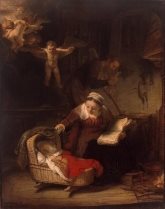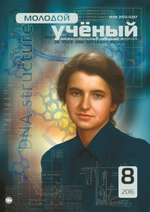The top of Dutch culture in 17th century was Rembrandt Harmenszoon van Rijn’s (1606–1669) creative work. The art of the great master as if sums up all achievements of Dutch art school and leads them out of the borders of his country and his epoch.
Rembrandt began his activity in Leiden — his first independent works belonged to the middle of the 20s; from 1632 till the end of his life Rembrandt worked in Amsterdam — the main art centre of the country. In the second half of the 20s and 30s Rembrandt looked for his own way and creative method.
Rembrandt learned reality, tried to seize its various aspects (his pictures are indicative of it), but he was mostly interested in individual human character and variety of phenomena in spiritual life. Rembrandt’s self-portraits of these years are different, often unexpected images: new sides of his nature or its emotional possibilities are discovered in the same man (the self-portraits in Boston and Munich, 1629).
Attention to the inner world of man defines originality of the first subject pictures of Rembrandt (“Toviy and His Wife”, 1625–1626; “Apostle Paul in the Darkness”, 1627). Accent to psychological experience of event which Rembrandt wants to see as though by the eyes of his members, is expressed especially bright in “Christ in Emmaus” (ab. 1629, Paris, the Jacmar-Andrew Museum). The painter shows personages’ reaction — worry, fear, shock. But, like in early self-portraits, emotional effects had been still monotonous, poses and gestures too demonstrative.
In the works created at the end of the 20s — the beginning of the 30s had already appeared a part of light as intensification means of emotional expressiveness of scene. In “Apostle Paul” light emphasizes the hero’s mood. In “Christ in Emmaus” light and shade opposition carries suddenness and power seized the apostle’s feeling.
At the same time with portrait historical painting became the main field of Rembrandt’s creative work.The subjects of Old and precept let give the work’s matter image scale, and its sense generalizing character. Though Rembrandt appealed to religious- mythical themes he didn’t refuse life truth of picture, — on the contrary his aim was to combine real, earthly concrete thing with the elevated spirit and sense which was included in legend.
However, the painting style of early period is contradictory. Rembrandt didn’t always manage to combine elevation and trustworth, grandeur of feelings and rude truth of reality organically. So in “Christ in Emmaus” contrast between ordinarity and wonderful event is too sharp.
Refusing stated convention and idealization Rembrandt deherozied the personages of religious and mythical legends, but at the same time he extremely accented prosaism of nature and lowland of passion. (“Samson’s Marriage”,1635, Dresden, the Picture Gallery). Sometimes Rembrandt lowers the image deliberately: the painter converted the nice fellow Hanimed into frightened and crying kid the eagle taking away in its claws (“Hanimed”, 1635, Dresden, the Picture Gallery). On the other hand, elevated thing, for Rembrandt, was identified with the external elevation of the scene, its pathetics and stormy dynamics, — the works created in the middle and second half of the 30s were influenced by Italian and Flamandian baroque not by accident (“Sacrifice of Avraam”, 1634, St.Petersburg, Hermitage; “Blindness of Samson”, Frankfurt am Main).
Rembrandt’s craving for wonderful splendour and dramatic collisions like his desire to debunk usual art norms and ideals were connected with the rush to run away from prosaism and town limitation of bourgeois life. Not everyday life but world of heroic spirit and fantasy attracted him. In the 30s he often painted himself and his relatives in “historical” costumes, wonderful and fantastic clothes. These imaginary portraits, as they are sometimes called, inspired the dream of a wonderful man, image elevated from everyday reality. In this period Rembrandt didn’t only search his own ideal of life and man — he created the work which portended his following creative way as well. “Removal from the Cross” (between 1633 and 1639, versions in Munich and St.Petersburg) was painted under the influence of Rubens’s famous composition, but the subject was interpreted by Rembrandt as the chamber scene: it gives a spectator possibility to feel human tragedy belonging to him, calling to itself — death of broken down and worn out with suffering Christ and his relatives’ grief. The light crossing the darkness creates the feeling of tense quiet, incandescence of things, grandeur of drama.
In the 30s Rembrandt was the most popular painter in Amsterdam. Success, fame and wealth came to him. The apprentices used tothrong his workshop.
Rembrandt had painted a lot of order portraits by that time. They are painted with high plastic force, give likeness wonderfully, catchcharacteristic thing in figure, but Rembrandt hadn’t found yet his own way in portrait painting. Perhaps, not by accident Rembrandt, portrait painter by nature, exactly in this genre — a group portrait of corporation of Amsterdam shots — managed to inspire ideal of heroic style, not falling in extremity of theatrical pathetics and sharpness, achieve organic merging of poetic elevation painted by note of fantasy and reality (“The Night Watch”, completed in 1642, Amsterdam, Rijksmuseum).
In the 40s Rembrandt repainted some of his works painted in the previous decade — it was eloquent illustration of the changes in the master’s art aspiration. The first version of the picture “Danaya” (St.Petersburg, Hermitage) was created in 1636. Mythical subject was given in effective smart decoration, but the hero herself struck by her ordinarity. Danaya’s figure, painted from the concrete model, is perfectly individual in its physical turn, its forms and proportions are too far from ideal norms of beauty. Statement of realistic vision of reality in picture nude body — that “sphere” of art where classical ideal dominated for a long time — obtained special bright, program character.

Fig. 1. Rembrandt. Danaya. 1636–1647. St. Petersburg, Hermitage
In 1646–1647 Rembrandt repainted the central part of the picture including Danaya and the Maidservant. The painter wasn’t satisfied with the “external” life truth only — he aspired to the inner truth. Face expression, new found in this version gesture of the right hand
reproduced the emotional state of the heroin — worry and gay, expectation and hope, impatience and call wonderfully exact and perceptible. In “nature truth” Rembrandt managed to recognize soul and moral beauty: Danaya is pretty because of sincerity and happy of her love shining her appearance. Wonderful, grateful thing becomes equivalent for Rembrandt inspired by experience.
His painting style also changed. In untouched parts of the pictures the forms, details are carefully transferred, the texture is neutral, the cold tones dominate in colour; in the central zone the painting is wide, free, and the colour is kept in warm golden and brownish
tones the painter liked in the mature period of his activity. The light functions got complicated — it obtains independent, various spiritual sense. In “Danaya” soft light shining begins to be perceived as the radiation of human feelings.
Poetry and truth are united in harmony in Rembrandt’s art. Discovery of poetic, elevated thing in reality, ordinarity, on the other hand, describing the subject not as an “eventful” collision, but as psychological collision — he found the solution of the problem in the matter now. Accent is carried to internal spiritual matter of image or event.
Rembrandt includes poeticization, inspiration into portrait characteristics (“The Man With the Falcon”, 1643, London; “The Portrait of Agatha Bass”, 1641, London). Henceforward, the painters self-portraits were not sketches of expression, but discovery of man’s inner world in various stages of his way of life, his spiritual evolution (the self-portrait in the London National Gallery, 1640).
In legends of sacred books Rembrandt aspired to find the human “ origin” close to everybody — he sees the moral merit and beauty in a common man and ordinary phenomena of life.
Lyric theme attracted Rembrandt so much not by accident in the 40s. Depths of feelings, tenderness and intimate warmth of relations poeticize the life of common people and give the feeling of its moral top (“The Holy Family”, 1646, Kassel, the Picture Gallery; “Toviy and His Wife”, 1645, Berlin-Dalhem, the Picture Gallery).
But lyricism of interpretation and concreteness in surroundings transference didn’t give the works genre character — inner significance took the matter of picture out beyond private episode.
“Kernel” of Rembrandt’s aesthetic intentions became creation of material and emotional environment surrounding man, indissolubly connected with his life, his inner world, the environment which more than image and equal to it expresses mood and sense of a scene.
In “The Holy Family” (1645, St.Petersburg, Hermitage) the scene is immersed in transparent semi-darkness, piercing with trembling golden colour in which action ceases and which absorbs emotional “voices” of the picture. Feeling shades give the feeling of experience protraction and at the same time the life course in time.

Fig. 2. Rembrandt. The Holy Family. 1645. St. Petersburg, Hermitage
So problematics of Rembrandt’s mature and late creative work had been confirmed by the second half of the 40s; then his new painting system was formed. Chiaroscuro was the fundamental creative element of the art structure. The light radiating radiation and warmth became an equivalent of the lyric feeling, — it defined spiritual atmosphere of a scene, it was a carrier of its ethic meaning. The light defined existence of colour in the picture, its expressive power as well. In “The Holy Family” the feeling of warmth as tenderness of maternal love is kept by red tones smouldering to the brownish dusk. The light as if appearing with the corporal shape at the same time gives it special lightness, and the space obtains depth and airiness thanks to chiaroscuro. The figures are merged with space in unity which is perceived as emotional environment full of feelings and experiences of man.
Plastic form gets special spirituality as well. Rembrandt painted Virsaviya’s body (“Virsaviya”, 1654, Paris, Louver) with such force and expression that it seems both wonderfully alive, real and expressive as if speaking. Each shape, turning, bend of the body, its “breath” in the degree of the face, head inclination, look express Virsaviya’s submission and passivity linking over David’s letter and her own destiny. Her soul state is created so deep and complete that the whole life of Virsaviya as if passes in front of her and a spectator’s look.
Decadence of Dutch art school began in the last quarter of the 17th century; orienting on new tastes and demands Dutch painters began to imitate foreign models losing the national originality.
References:
- Беляцкая B. П. Пособие по английскому языку для художественных вузов и факультетов, Mocквa, “Bысшая школа”, 1974
- Большой энциклопедический словарь. Mocквa, 1985
- Пpycc И. E., Maлая история искусств. 3aпaдно — eвpoпeйское иcкyccтвoXVII вeкa, VebVerlagderKunstDresden, 1974; “Искусство”, Mocквa, 1974
- Poтeн6epr E. И., Голландское искусство XVII вeкa, Mocквa, 1972
- The World Book Encyclopedia, V. 1, 7, 9, 15, Chicago London Sydney Toronto, 1994







